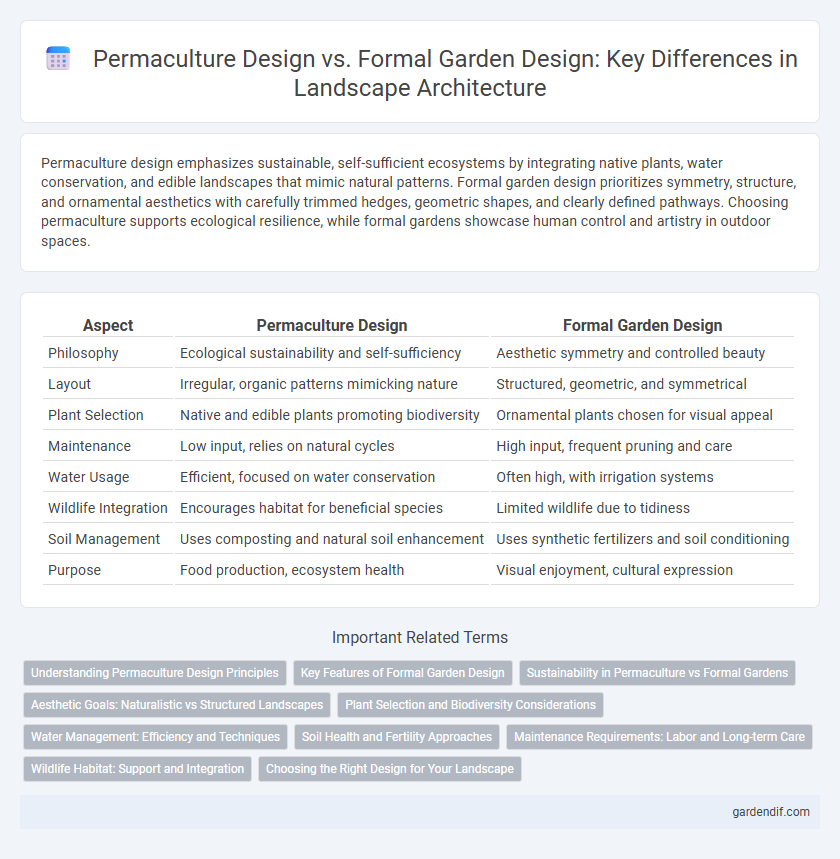
Permaculture Design vs Formal Garden Design Illustration
Permaculture design emphasizes sustainable, self-sufficient ecosystems by integrating native plants, water conservation, and edible landscapes that mimic natural patterns. Formal garden design prioritizes symmetry, structure, and ornamental aesthetics with carefully trimmed hedges, geometric shapes, and clearly defined pathways. Choosing permaculture supports ecological resilience, while formal gardens showcase human control and artistry in outdoor spaces.
Table of Comparison
| Aspect | Permaculture Design | Formal Garden Design |
|---|---|---|
| Philosophy | Ecological sustainability and self-sufficiency | Aesthetic symmetry and controlled beauty |
| Layout | Irregular, organic patterns mimicking nature | Structured, geometric, and symmetrical |
| Plant Selection | Native and edible plants promoting biodiversity | Ornamental plants chosen for visual appeal |
| Maintenance | Low input, relies on natural cycles | High input, frequent pruning and care |
| Water Usage | Efficient, focused on water conservation | Often high, with irrigation systems |
| Wildlife Integration | Encourages habitat for beneficial species | Limited wildlife due to tidiness |
| Soil Management | Uses composting and natural soil enhancement | Uses synthetic fertilizers and soil conditioning |
| Purpose | Food production, ecosystem health | Visual enjoyment, cultural expression |
Understanding Permaculture Design Principles
Permaculture design principles emphasize sustainable, self-sufficient ecosystems by integrating native plants, water conservation techniques, and natural patterns to mimic local habitats. This approach contrasts with formal garden design, which prioritizes symmetry, structured layouts, and ornamental aesthetics often requiring intensive maintenance. Understanding permaculture involves recognizing its core ethics--earth care, people care, and fair share--and applying principles like zoning, diversity, and energy efficiency for resilient landscape management.
Key Features of Formal Garden Design
Formal garden design emphasizes symmetry, geometric shapes, and precise patterns to create a structured and orderly appearance. It typically features clipped hedges, neatly trimmed topiaries, and carefully arranged flower beds or pathways that highlight balance and repetition. Water features, statues, and gravel or paved walkways often enhance the aesthetic, reinforcing the garden's controlled and refined layout.
Sustainability in Permaculture vs Formal Gardens
Permaculture design prioritizes sustainability through ecological balance, soil health, and water conservation by integrating native plants and renewable resources, fostering resilient ecosystems. Formal garden design often emphasizes aesthetic symmetry and maintenance-intensive features, which can result in higher water usage and chemical inputs. Sustainable permaculture practices reduce environmental impact by promoting biodiversity and natural cycles, unlike formal gardens that frequently depend on external inputs and frequent interventions.
Aesthetic Goals: Naturalistic vs Structured Landscapes
Permaculture design emphasizes naturalistic aesthetics, creating landscapes that mimic natural ecosystems with diverse plant species and organic patterns. Formal garden design prioritizes structured landscapes, featuring symmetrical layouts, geometric shapes, and meticulously trimmed plants. This contrast highlights permaculture's focus on ecological harmony versus formal gardens' emphasis on visual order and precision.
Plant Selection and Biodiversity Considerations
Permaculture design emphasizes diverse, native, and edible plant species that create self-sustaining ecosystems, prioritizing soil health and water efficiency. Formal garden design typically features symmetrical layouts with ornamental plants selected for aesthetic uniformity and seasonal color palettes. Biodiversity in permaculture promotes habitat for wildlife and resilience, while formal gardens often limit species variety for controlled appearance and maintenance.
Water Management: Efficiency and Techniques
Permaculture design prioritizes water management through techniques like rainwater harvesting, swales, and contouring to maximize natural infiltration and reduce runoff. Formal garden design often relies on structured irrigation systems and precise drainage layouts to maintain aesthetic symmetry and plant health. Permaculture's water-efficient, regenerative methods contrast with the higher water input requirements typical of formal gardens.
Soil Health and Fertility Approaches
Permaculture design emphasizes building soil health through layered planting, permanent ground cover, and organic matter recycling, fostering natural nutrient cycles and enhancing microbial activity. Formal garden design often relies on structured soil amendments, synthetic fertilizers, and intensive tilling, which can disrupt soil ecosystems and reduce long-term fertility. Integrating permaculture principles improves soil structure, moisture retention, and biodiversity, creating a self-sustaining system compared to the maintenance-intensive approach of formal gardens.
Maintenance Requirements: Labor and Long-term Care
Permaculture design emphasizes low-maintenance, self-sustaining ecosystems that reduce labor through natural processes like mulching, composting, and polycultures, promoting long-term soil health and biodiversity. Formal garden design demands frequent upkeep, including regular pruning, mowing, and pest control, to maintain its structured aesthetic and geometric patterns. The ongoing care in formal gardens leads to higher labor intensity and resource use compared to the regenerative approach of permaculture systems.
Wildlife Habitat: Support and Integration
Permaculture design prioritizes creating wildlife habitats by integrating native plants, water sources, and shelter to support biodiversity and ecosystem health. In contrast, formal garden design often emphasizes aesthetic symmetry and controlled plant selection, which may limit habitat availability for local wildlife. Supporting wildlife through permaculture fosters natural pest control, pollination, and resilience within the landscape.
Choosing the Right Design for Your Landscape
Permaculture design emphasizes sustainable and self-sufficient ecosystems by integrating native plants, water conservation, and natural patterns to enhance biodiversity and soil health. Formal garden design prioritizes symmetry, structured layouts, and ornamental features that showcase aesthetic precision and classic landscaping elements. Selecting the right design depends on your landscape goals, whether prioritizing environmental sustainability with permaculture or achieving visual order with formal garden aesthetics.
Permaculture Design vs Formal Garden Design Infographic

 gardendif.com
gardendif.com